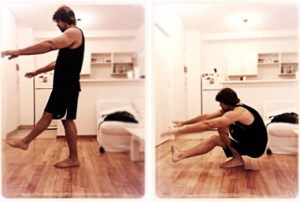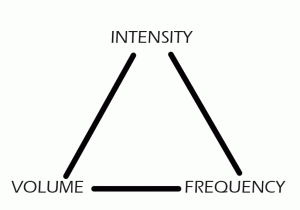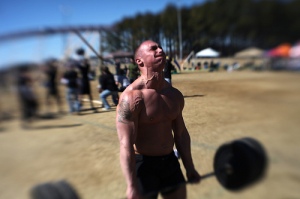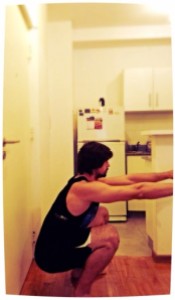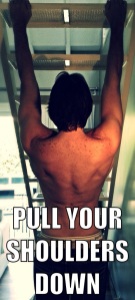Far from still being the underground turned culty fitness tool that it was half a decade ago, KBs have come into the mainstream. There’s a lot said about how and when to use this tool, and their apparant benefits. All this aside, what I’m happiest about is, I no longer have to describe a cannonball with a handle, most everyone knows what it is.
Why use Kettlebells
The kettlebell is, in my opinion, one of the best tools out there for overall fitness for the everyday Joe and Jane. Kettlebells can and will help you develop
- Strength: this are the grinding movements
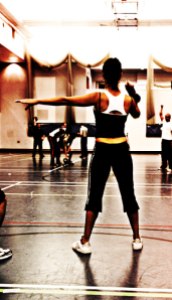
Clean the kettlebell strongly, else you’ll bang up your forearm! – Photo by Ken Liu
- Conditioning: through repetitive ballistics
- Flexibility: if used wisely
- Power: Through heavy ballistic excercises
- Mobility: think windmills and TGUs.
Are they the best tools for each job. Hell no. But they’re good for the development of an all around athlete/enthusiast. And, they’re very easily integrated with other tools.
(I could get into more detail about the advantages of practicing the hip drive or how all these attributes can be trained. But that’s a subject for a book, and not a blog post)
Disadvantages of kettlebells (why not use kettlebells)
They’re not a specialist’s tool. If you want to be the strongest or the most powerful, you can’t beat a barbell. You want to be the most flexible, yoga is your tool. You want to be the best at anything, there are appropiate tools that will let you specialize in each: endurance, flexibility, mobility, strength, hyperthorphy… All can be improved with a KB, but no to the same level as.
So, Why use kettlebells then?
Kettlebells will give you a blend of strength, endurance and power that can’t really be described as “strength-endurance” or “power-endurance” but more as an: ease of being. Having practiced on and off with kettlebells (sometimes my goals are more specialized) I can attest to the fact that any regular task gets easier (like playing football(or soccer) for about two hours with legs that just won’t quit), that joint health increases, and that the grass gets even greener (ok, maybe not that much).
In other words, unless you’re focused on a particular sport, kettlebells are probably the right tool for you.
The Workouts
1) KB solo
This an beginner to intermidiate plan and should be done 3 or 4 times a week. Please keep your recovery in mind. It has an all around focus (if you want to go more frequent, change the number of sets to 3). Don’t ever go to failure!
A1) TGU 3×3
Rest 1-2 minutes between sets. Go heavy, but never to failure.
B1) Clean + Military Press 5×5
B2) KB one arm row 5×5
Rest one minute between each excercise
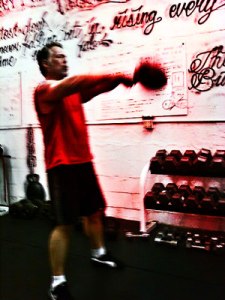
Expect a healthy sweat! Photo by John Calnan
C1) Goblet Squat 5×5-10
C2) Heavy KB 1H Swings or Snatches 5×5
Rest one minute between each excercise.
D1) Kettlebell 2H swings 5x 15-20
Rest 30″ to 1 minute between sets. Jog in place or jump an imaginary rope.
After this have a cool down with stretches and some mobility work for recovery.
2) KB + Bodyweight
This is an all arounder that will hit each and every movement pattern in the most effective way I know of. Do this 4 times a week.
Day 1
A) TGU 3×3 (can’t beat this baby)
Go heavy. But never to failure. Rest one or two minutes between sets.
B1) KB Clean + Press 5×5
B2) Pullup progression 5×5 (pick one you can do up to 8 reps barely). If this is your pull-up, weight them!
Rest 1 minute between excercises
C1) Goblet Squat 5×5
C2) 1H heavy swings 5×5
Rest one minute between excercises.
D1) Burpees 5x as much as you can with perfect form (I don’t care about speed here, just go as fast as you can while remaining as controlled as you can).
Day 2
A) Handstand holds 3x 50% of your max holding time.
Keep your body straight (or better yet, face the wall and touch it with your chest). Rest one or two minutes between each set.
B1) Push-up progression (or dips) 5×5
B2) KB Row 5×5
Rest 1 minute between each set
C1) Pistol Squat progression 5×5 (use a progression you can do about 8 perfect reps, but not 9)
C2) KB Snatch or 1H heavy swing 5×5
Rest 1 minute between each set
D1) Kettlebell 2H swing 5x as many as you can with perfect form and a solid hip drive.
After you finish each workout, cool down with some stretches and mobility work for recovery.
Conclusion
If you can use them, Kettlebells are a great addition to any fitness program, just be mindful of what your goals are and what you’re looking for. If you want to be a specialist, then the KB is probably not your cuppa. If, on the other hand, you’re looking for all around development to above average, but not elite levels, then by all means, go buy the damned thing!
Shameless advertising bit – where I learned most of kettlebells from

One of the best damn books to get you started, and then some
To finish this post off I’d like to share with you where I learned most kettlebell skills and probably the most important book to have in a kettlebell library. The Russian Kettlebell Challenge (affiliate link). by Pavel Tsatsouline is a golden oldie. Even though there have been several other great books by the same author (Enter the Kettlebell and Simple & Sinister
(affiliate link). by Pavel Tsatsouline is a golden oldie. Even though there have been several other great books by the same author (Enter the Kettlebell and Simple & Sinister to say the least) this one I believe is the most complete of the three, the only lacking part I found is: there’s no information on the TGU (which later became a staple in both his certifications, and an exercise that one must simply do).
to say the least) this one I believe is the most complete of the three, the only lacking part I found is: there’s no information on the TGU (which later became a staple in both his certifications, and an exercise that one must simply do).
*Note: all the above links are from affiliate programs and will lead you either to Dragondoor or Amazon product pages. Just FYI.
Motus Virtute


